Big Red Book
Celebrating television's This Is Your Life
Anne BRUSSELMANS (1905-1993)

THIS IS YOUR LIFE - Anne Brusselmans, former resistance leader, was surprised by Eamonn Andrews backstage at the BBC Television Theatre, having been brought there by her biographers, Peter and Sylvia Duncan, and led to believe she was there to watch a different programme.
Anne, who lived in Brussels, was recruited by her local padre in September 1940 to give shelter and help to Allied airmen during the German occupation of Belgium in the Second World War. As a result, she became a crucial player in the Comet Line evacuation network, formed in May 1940 to help downed RAF airmen return to Britain. The line began in Brussels, where the men were fed, clothed, given false identity papers and hidden in private houses. The network then guided the airmen south through occupied France into neutral Spain.
Anne and her family were responsible for sheltering 176 airmen in their Brussels flat while living under constant threat from the Gestapo. Risking her own life on numerous occasions, Anne played a leading part in helping over 600 men return home through the escape line during the four-year occupation of Belgium by the Germans.
"The book is the most wonderful souvenir I possess - always a reminder of a very pleasant experience in England"
programme details...
- Edition No: 43
- Subject No: 43
- Broadcast live: Mon 25 Nov 1957
- Broadcast time: 7.30-8.00pm
- Venue: BBC Television Theatre
- Series: 3
- Edition: 9
on the guest list...
- Bronck Malinowski
- Tom Reynolds
- Fred Allen
- Alfred Beard
- Robert Clarke
- Julien - husband
- Yvonne - daughter
- Jacques - son
- Pastor Schyns
- Raymond Itterbeek
- Leopold Detinne
- Maj Henry Sarnow
- Lea Knops
- group of friends - live link from Brussels
- ACM Sir Ronald Ivelaw-Chapman
- Douglas Eldridge
- Ken Garvey
- G H Mellor
- S Lawrence
- Flt Lt Lamport-Newton
- W Palmer
- Gerry Lorne
- Sqn Ldr Bill Norfolk
related appearance...
- Anna Neagle - Feb 1958
production team...
- Researchers: Nigel Ward, Ray Marler
- Writer: Peter Moore
- Director: unknown
- Producer: T Leslie Jackson
- names above in bold indicate subjects of This Is Your Life
saluting the armed forces
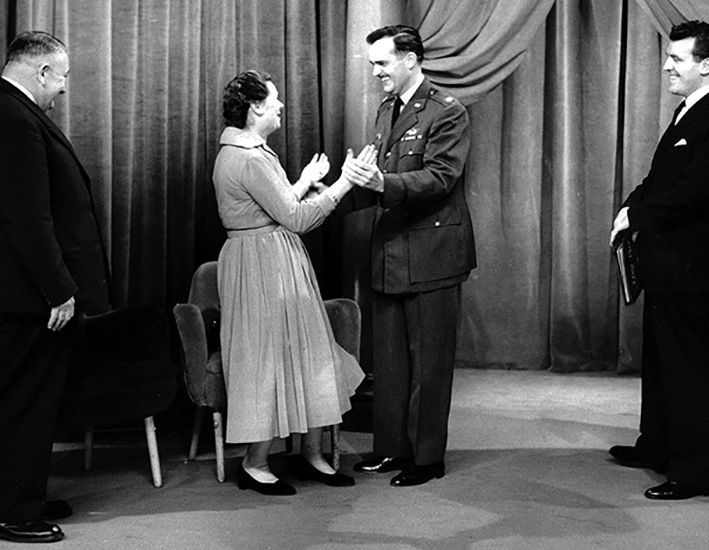
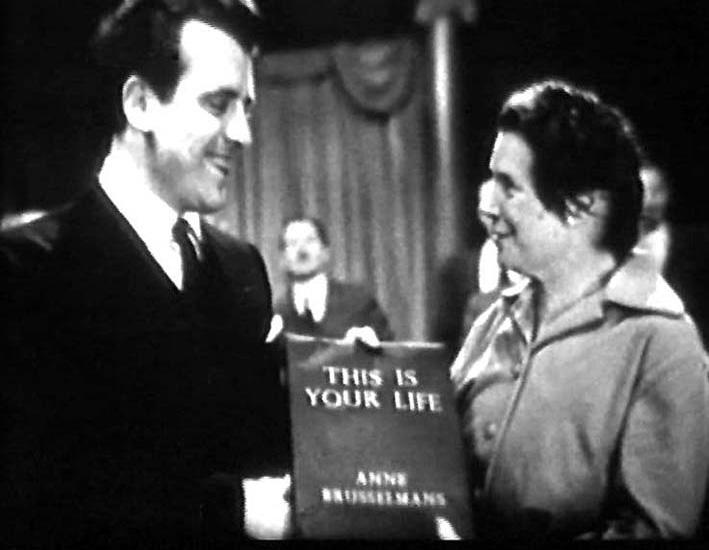
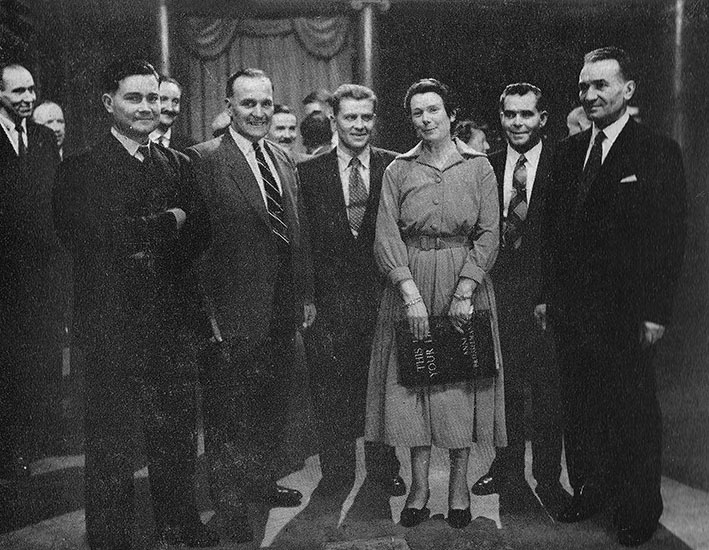
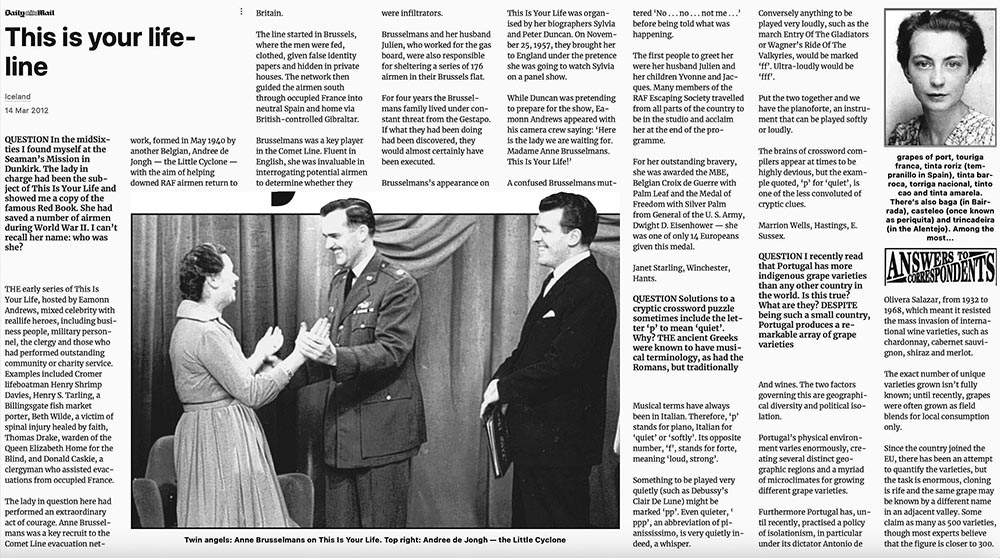

Photographs of Anne Brusselmans This Is Your Life

In 1956, while in London, I was a guest on a talk show. As I was leaving the set, I was approached by a member of the This Is Your Life television program. The producer was interested in making Mother the subject of a future show.
At first I questioned the wisdom of such a project. Mother had been left with a heart condition after the war, and I was concerned about the effect on her health were she to be abruptly propelled on a stage by someone telling her: "Madame Brusselmans, you are among friends. This is your Life!"
I asked for some time to return to Brussels to confer with her Doctor, before giving a reply. After consulting with Doctor Delune, who had also tended to the wounded airmen during the war, I was able to give an affirmative answer to the BBC.
For the next nine months, I worked with the writers for the show. We screened potential guests who had worked with Mother during the war, and we swore people to secrecy, for the program would be replaced if she became aware of its existence - and this included my father and brother. I thought it wiser not to tell Dad for fear he might tell Mother. They had no secrets, and I did not trust him with this one. Only a few days before we departed for London did I bring him into the picture. He, too, was afraid of the impact the show would have on Mother, but I appeased him by telling him I had the approval from her Doctor.
The lies I told, the stories I concocted to get some answers posed by the BBC and which I was unable to answer, are countless. Nigel Ward, one of the writers, spent a week in Brussels putting the finishing touch to the script. We interviewed the guests who were to fly to England to appear on the show. We made arrangements for the appearance of others by satellite, with the help of the Belgian television studios, and, in the evening, I took Nigel to some of our best-known tourist attractions. The evening before Nigel was to return to London, he fancied meeting Mother without her knowing who he was.
Now, this really presented a problem, but we quickly solved it. He was young enough to pass as a boyfriend I might have met in London. I asked my parents to entertain him for dinner, as this was his first visit to Brussels. We dined at their house in La Halpe, and then, as customary when we had foreign visitors, my father suggested we take him downtown to see the sights. I dared not look at Nigel when we reached the Grand Place where only the evening before we had dined and walked around. He raved at the sight of our famous little cherub fountain, Mannekin-Pis, created in 1619, just as he had a few days before. What an actor! Finally, we took him back to his hotel, and I was relieved the evening was over.
My next task was to talk Mother into accompanying me on my visit to London a few days before showtime, on November 27, 1957. She found all sorts of excuses, perhaps the most important one that she had a backlog at work (she was Administrative Assistant at the Von Karman Institute at the time). Fortunately, her boss, Paul Harrington, was a good friend of mine, and he talked her into taking a few days rest. The RAFES invited her to a "mock" meeting to arrange the next visit of helpers to London, and only then did she agree to come along with me.
Prior to leaving Brussels, Mother prepared several meals for both my father and my brother. She duly left instructions where she was staying, not knowing that soon after our departure, they too were due to leave for London by plane. Both Dad and I exchanged an understanding look, and accepted her recommendations.
Mother and I were staying in the suburbs of London with friends. The day before the show, I joined the Belgian helpers in the city for rehearsals at the studios.
November 27 finally came and the friends we were staying with pretended to be part of a television panel. They asked Mother if she wished to watch their appearance on the program. She agreed, and as we were whisked into a dressing room with strict instructions to remain very quiet, she was driven to the studios by our friends and taken into an adjacent dressing room. When the time came for them to go on stage, she was escorted to a "good seat" to watch the show. Instead, she was guided to the stage door. Hearing the noise made by the audience and seeing the host Eamonn Andrews, she tried to back away, thinking they had accidentally opened the wrong door. But Eamonn took her by the hand on to the stage, saying "Madame Brusselmans, have no fear, you are among friends This is your life!"
From that moment on, a parade of guests appeared on stage, one after the other: Pasteur Schyns, who had enrolled Mother in the Underground, Hank Sarnow, who was then stationed in Madrid, Spain; and several other close "helpers," some of whom had spent time in concentration camps. Mother was then invited to watch the relay from Brussels on the monitor. Sitting in the Belgian studios were more of her closest contacts who were unable to participate in London. Her biggest surprise was to find her husband and son suddenly emerge on stage.
"What are you doing here? I thought you were home eating the stews I left for you," she said.
One of Mother's helpers during the war, Monsieur D.. a man condemned to death by the Germans, was having trouble with English. During the last rehearsal we had finally resorted to have the few words he had to speak written on the palm of his hand. All he had to do was read the sentence when meeting Mother on the stage. What none of us thought of was that in his state of nervousness, the sweat erased the words and all we heard was: "She Madame Chief."
The "finale" of the program was most stirring as Eamonn called out to the audience, "Are there any more airmen here who were helped by this lady?" Evaders, mostly British, came walking up the aisles to join us on stage, and we were surrounded by many of them.
And Nigel Ward, the writer of the show - as soon as the program was over, Mother, having recognised him, walked over and told him: "Nigel, you are a liar!"
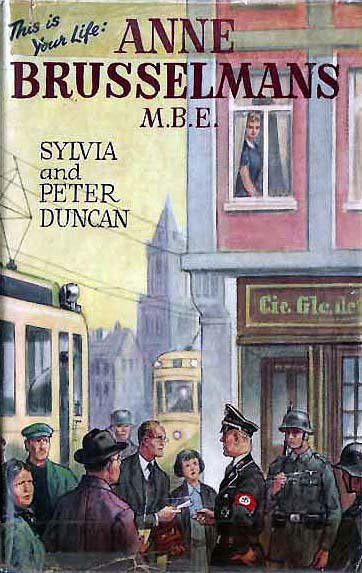
Peter Duncan first met Anne Brusselmans when she broadcast on 'In Town Tonight', of which he was producer.
Feeling that tribute should be paid to her, he arranged for her to appear on the BBC Television programme This Is Your Life.
Some time later, the unsuspecting Mme. Brusselmans, spending a weekend with the Duncan family, was taken to the studios, ostensibly to watch her hostess, Sylvia, appear on television.
On stage she met some of the 176 men who had stayed in the Brusselmans' flat and others of the 600 who had got home through the escape line, in which she had played a leading part...
Five people sat in a dressing-room above the BBC Television Theatre at Shepherd's Bush awaiting a BBC production. They were Sylvia and Peter Duncan, Madame Anne Brusselmans, and two script writers.
Sylvia sat before the mirror renewing her lipstick. She was supposed to be appearing in a panel game, and Madame Brusselmans, who had spent the weekend with the Duncans, had been invited to watch the production.
Someone knocked on the door. A call-boy entered and said, 'They're ready now.' The four wished Sylvia good luck, the script writers escorted her downstairs, with Peter and Anne following behind.
At the entrance to the studio the script writers disappeared. Sylvia walked in first, closely followed by Peter and Anne, then she dropped to Anne's other side as Eamonn Andrews approached saying, 'Here is the lady we are waiting for. Madame Anne Brusselmans... This Is Your Life!'
Anne was confused. She muttered, 'No... no... not me...' and tried to push Sylvia forward.
Peter, supporting her with his arm, whispered, 'Anne... it's all right... all your friends are out there waiting for you.'
Still hardly able to understand what was happening, Anne followed Eamonn to lead her on to the stage. Almost at once he brought her husband, Julien, and her children, Yvonne and Jacques to stand by her side.
Viewers heard how she, an ordinary housewife and mother had helped a hundred and seventy-six Allied airmen to evade capture by the Germans during the war.
Many members of the RAF Escaping Society travelled from all parts of the country to be in the studio and acclaim her at the end of the programme.

Daily Mail 14 March 2012
Question:
In the mid-Sixties I found myself at the Seaman's Mission in Dunkirk. The lady in charge had been the subject of This Is Your Life and showed me a copy of the famous Red Book. She had saved a number of airmen during World War II. I can't recall her name: who was she?
Answer:
The early series of This Is Your Life, hosted by Eamonn Andrews, mixed celebrity with real-life heroes, including business people, military personnel, the clergy and those who had performed outstanding community or charity service.
The lady in question here had performed an extraordinary act of courage. Anne Brusselmans was a key recruit to the Comet Line evacuation network, formed in May 1940 by another Belgian, Andree de Jongh – the Little Cyclone – with the aim of helping downed RAF airmen return to Britain.
The line started in Brussels, where the men were fed, clothed, given false identity papers and hidden in private houses. The network then guided the airmen south through occupied France into neutral Spain and home via British-controlled Gibraltar.
Brusselmans was a key player in the Comet Line. Fluent in English, she was invaluable in interrogating potential airmen to determine whether they were infiltrators.
Brusselmans and her husband Julien, who worked for the gas board, were also responsible for sheltering a series of 176 airmen in their Brussels flat.
For four years the Brusslemans family lived under constant threat from the Gestapo. If what they had been doing had been discovered, they would almost certainly have been executed.
Brusselmans appearance on This Is Your Life was organised by her biographers Sylvia and Peter Duncan. On November 25 1957, they brought her to England under the pretence she was going to watch Sylvia on a panel show.
While Duncan was pretending to prepare for the show, Eamonn Andrews appeared with his camera crew saying: 'Here is the lady we are waiting for. Madame Anne Brusselmans This Is Your Life!'
A confused Brusselmans muttered 'No... no... not me...' before being told what was happening.
The first people to greet her were her husband Julien and her children Yvonne and Jacques.
Many members of the RAF Escaping Society travelled from all parts of the country to be in the studio and acclaim her at the end of the programme.
For her outstanding bravery, she was awarded the MBE, Belgian Croix de Guerre with Palm Leaf and the Medal of Freedom with Silver Palm from General of the US Army, Dwight D Eisenhower – she was one of only 14 Europeans given this medal.
Series 3 subjects
Albert Whelan | Colin Hodgkinson | Vera Lynn | Arthur Christiansen | John Logie Baird | Richard Carr-Gomm | Jack TrainEdith Powell | Anne Brusselmans | Norman Wisdom | Victor Silvester | Jack Petersen | Lucy Jane Dobson
David Bell | Matt Busby | Minnie Barnard | Gordon Steele | Louie Ramsay | Tubby Clayton | Daniel Angel
Anna Neagle | 'Dapper' Channon | Frederick Stone | Paul Field | Noel Purcell | Barbara Cartland
Harry Secombe | Archie Rowe | Humphrey Lyttelton | Francis Cammaerts | A E Matthews